Abstract
The purpose of this study is to identify the level of life satisfaction and the differences regarding life satisfaction among the students from the University of Bucharest. In order to measure the level of satisfaction we applied an instrument designed for psychological testing – Multidimensional Studentsʼ Life Satisfaction Scale (MSLSS). The participants selected for this research were 140 students from the University of Bucharest, both male and female. The research results were processed in SPSS. After applying the descriptive statistics and the T-test for identifying the studentsʼ differences by gender, it was noticed a higher level of satisfaction at the male students. Furthermore, there were also noticed considerable differences on the five domains of the questionnaire: family, friends, school, living environment and self. Findings of the study showed significant differences in terms of satisfaction level for the two categories of subjects, so the training and development of self-image is influenced by the four areas of the life of every individual.
Keywords: Lifesatisfactionpositive psychologyacademic environmentself-content
Introduction
Whereas life satisfaction of adults has already been the focus of numerous studies (Diener, 1994),
life satisfaction in childhood and adolescence is yet to become the primary objective of scientific
research. The present paper therefore comes as a result of this need to study life satisfaction in
adolescence and early adulthood, since this concept exhibits multiple implications for the personality
development and formation. Concurrently this paper comes in handy for those educators who seek for a
legitimate and differentiated intervention upon their students, in respect of their life satisfaction level. If
an adolescent learns how to be life satisfaction oriented (in other words, how to be grateful for all the positive things in his/her life), the quality of his/her life improves considerably, the incidence of
depression decreases etc. At the same time, life satisfaction is known to foster a psycho-social climate
based on trust and self-content. The positive effects of a high level of life satisfaction are achieved
through positive actions and favorable life experiences. These require the development of an open and
empathetic attitude towards new, innovative and creative situations, all of which enable a harmonious
personality development for each individual.
Theoretical Foundation and Related Research
A series of authors has described life satisfaction as a “global evaluation by the person of his or
her life” (Pavot, Diener, 1993, p. 164). This complex assessment includes not only an emotional
evaluation, but also a cognitive evaluation of oneʼs life. (Diener, Oishi & Lucas, 2003) Life satisfaction
therefore encompasses the whole life of an individual, with all its different aspects. It implies fulfilling an
individualʼs needs, wishes and desires (Ardahan, 2012) and it represents the “emotional reaction of an
individual to life, which is defined as work, leisure and other non-work time”. (Hong & Giannakopoulos,
1994)
The concept of life satisfaction has proved to be of great importance in understanding children and
adolescents’ psychological well-being. Life satisfaction reports, for instance, have often been
distinguished from other constructs, known to fall under the category of well-being, such as positive
affect (Lucas et al., 1996; Huebner, 1991; Huebner & Dew, 1996; Huebner, 2001), self-esteem,
depression (Lewinsohn, Redner & Seely, 1991) or others. Aside from this difference between satisfaction
and well-being, life satisfaction has also been distinguished from happiness. For example, ( Mohammadi,
2011, p. 1843) defines satisfaction as follows: “in contrast to the concept of happiness, which refers to
emotional experience (excitements and feelings), satisfaction indicates a recalling knowledge and is
definable as the perceived difference between wish and progression. This definition comprises a range
which extends from success to deprivation feeling.”
Cummins and Cahill (2001) classify the factors that improve life satisfaction into three distinct
categories: individual-based variables (such as personality traits), cognitive variables (control, self-
esteem, optimism etc.) and socio-environmental factors (Bramson et al., 2002; Agyar, 2013). In the same
train of thought, Sahin (2008) lists a series of factors that are known to influence life satisfaction, such as:
health, confidence, relationship with parents, siblings and relatives, having a child and raising him/her,
helping others, taking others into consideration, joining events, learning, understanding him/herself,
having a job, socializing, reading, listening to music, watching movies, and participating in entertainment.
As regards Sahinʼs first listed factor (health), Beutell (2006) seems to share a similar view, stating that
life satisfaction is tightly connected to an individualʼs mental health. Thus, when individuals are satisfied
with their life as a whole, their mental health will also enhance. In this case however, it is satisfaction that
influences mental health and not vice versa. In addition to Sahin and Beutellʼs opinion, a high level of
satisfaction was also proved to attenuate family conflicts and implicitly improve a personʼs psychological
health level within the society. (Mohammadi, 2011)
In any event, physical health, psychological resilience and mental health remain three of the most
frequent characteristics of satisfied people (W.E., 1996). At the same time, the differences between
satisfied and dissatisfied people are displayed in their social skills. According to Roberts (2007), a high
level of life satisfaction is known to enhance social assertiveness and empathy, two characteristics which
dissatisfied people usually lack. Research has also shown that dissatisfied people have difficulties in
managing the events around them, while satisfied people are more likely to be in control of their
environment. Hence, being able to control the immediate environment is definitely linked to the
individualʼs level of life satisfaction. (Alahdad et al., 2014)
In terms of university students, life satisfaction is just as important as it is for adults. One of the
links between school and positive psychology (and life satisfaction implicitly) is focusing on teaching
people how to trust themselves and not to be afraid of engaging in positive experiences which bring them
happiness (for instance, relationships based on love or professional success built on effort and
perseverance) (Pânișoară et. al, 2016). Furthermore, life satisfaction appears to indicate an individualʼs
ability to handle important life tasks and social roles such as work. When referring to school, this “work”
is translated to academic retention and the ability to complete a degree and continue oneʼs studies.
(Frisch, 2006)
In Civitciʼs opinion (2015), life satisfaction is part of the subjective well-being, also known as
“happiness”, which is one of the positive indicators of adjustment to be altered by the studentsʼ stressful
everyday lives. For example, not few are the situations in which students who go to university are forced
to leave home and change their residence. Thus they have to rapidly get used to an abundance of new
people and places. (Ozgur et al, 2010) In this case, the difference between previous expectations and
actual facts points out the level of life satisfaction gained throughout the accommodation process. In other
words, satisfaction can be regarded as an individualʼs success in achieving his/her goals. (Topaloglu,
2015).
Methodology
Research Objective
The primary objective of this research is to identify the level of life satisfaction and the differences
in terms of life satisfaction on five specific domains (family, friends, school, living environment and self)
among the students from the University of Bucharest. A secondary objective of this study is to analyze
the previously identified level of satisfaction among the students from the University of Bucharest,
alongside with the differences between each of the domains under discussion.
Hypotheses
H1. There is a high level of life satisfaction at the students from the University of Bucharest.
H2. There are differences by gender regarding the studentsʼ level of satisfaction.
H3. There are significant differences in terms of studentsʼ satisfaction on the following five domains:
family, friends, school, living environment and self.
Subjects
The participants selected for this research were 140 students: 70 male students and 70 female
students. The participants were selected randomly, without taking into account their specialization.
Methods
The instrument designed for psychological testing – Multidimensional Studentsʼ Life Satisfaction
Scale (MSLSS) – is aimed to offer a multidimensional profile of how children and adolescents perceive
life satisfaction. The results obtained after applying the test are meant to assist specialists in the processes
of diagnosis, prevention and intervention. The MSLSS was particularly designed for: (a) providing a
multidimensional profile on children and adolescentsʼ satisfaction, based on particular domains of their
life (e.g. school, friends, living environment) and (b) determining their general level of life satisfaction.
For this study it was used the MSLSS Version 200, designed by Scott Huebner. The 40-item
MSLSS is designed for being used on students both individually or in groups. This type of differentiated
assessment leads to a more precise diagnostic, prevention and intervention.
Results
The results were introduced and processed using the SPSS software for statistical analysis.
In order to identify the level of life satisfaction for all the subjects selected for this study, we used
the descriptive statistics (number of subjects, sum, mean and standard deviation) from Table
Considering the indicatorsʼ limits within the questionnaire, we can state that the mean = 122.2714 shows
a high level of the studentsʼ life satisfaction, which confirms the first hypothesis of this study. A high
level of life satisfaction involves self-content, as well as appreciation of life and interpersonal
relationships. Therefore, the participants in this study are psycho-emotionally balanced and this supports
their personality development and social integration.
Table
there are statistically significant differences in terms of studentsʼ life satisfaction for each of the five
domains of this concept. We can notice the high scores of the male subjects, on the “friends” domain
(mean = 30.42), which indicate a higher level of self-content and social adaptation within the boysʼ
groups of friends. Furthermore, it is interesting to note the lower scores achieved by both categories of
subjects on the “family” and “friends” domains, although they represent two fundamental elements of
interpersonal life.
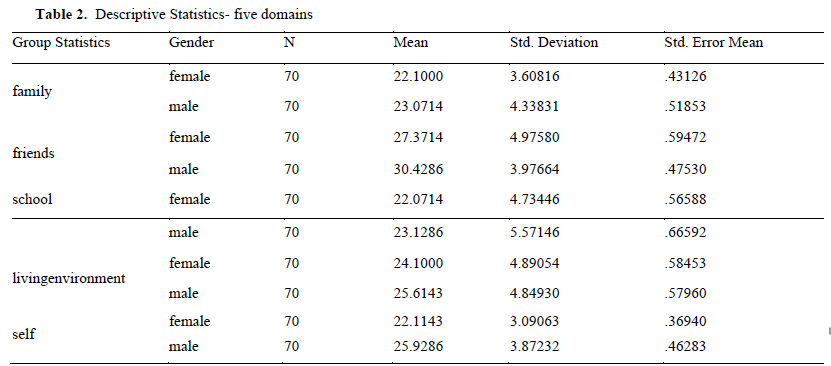
Table 3 shows the descriptive results of the life satisfaction level for the two categories of subjects.
We can notice how the male subjects have a higher mean than the female ones. In Table 3 it can be
noticed a mean of 126.4857 for the boysʼ level of satisfaction, which is approximately 8 decimals higher
than the girlsʼ mean and which concurrently allows for the assertion that boysʼ perspective upon life is
more likely to include traits such as independence, autonomy and self-confidence.
The second hypothesis will also be confirmed by the T-test for independent samples in Table
4.Table 4 illustrates the T-test results for independent samples, that confirm the second hypothesis,
according to which there are statistically significant differences by gender regarding the studentsʼ level of
satisfaction. The value of p=.044, which means that there is a statistically significant difference between
the two groups, therefore the second hypothesis can be accepted. Considering the differences between the
male and the female students in terms of life satisfaction, we can state that the male students perceive
their relationships and the events around them as being favorable for their personal and professional
development.
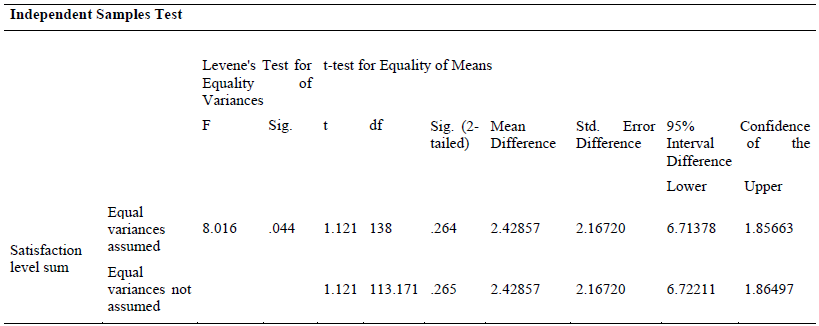
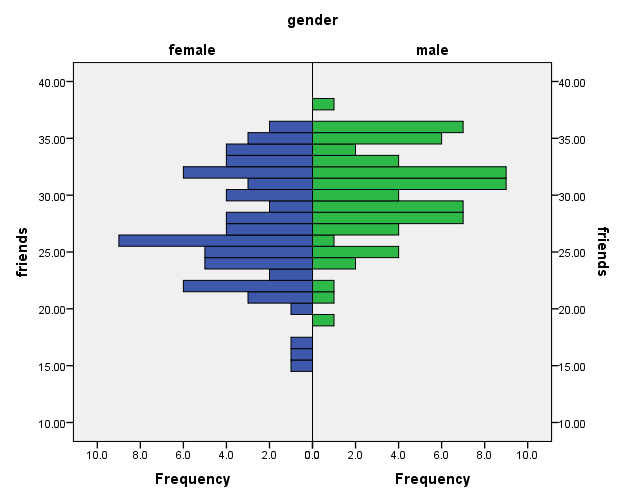
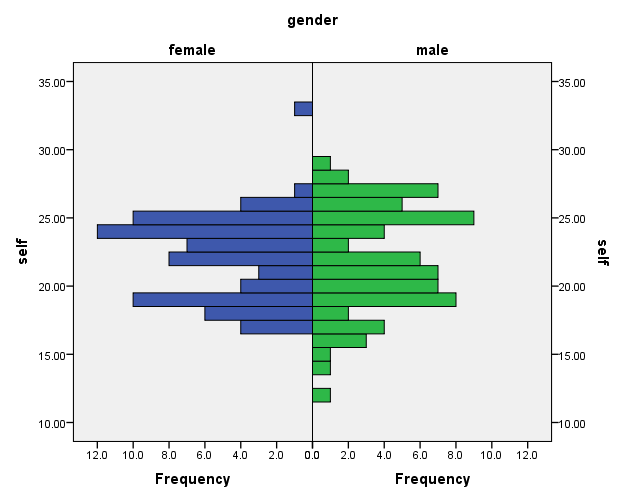
The histograms from Figures
domains of life satisfaction. In Figure
“friends” domain. Therefore, the main role of these graphs is to highlight the confirmation of the
hypotheses through the explicit scattering degree of the answers.
Figure
show an appropriate level of self-confidence and self-content. The answersʼ mean for the two categories
of subjects, in point of the level of self-satisfaction, ranges from 20 to 25% of all answers.
The histograms from Figures
environment and school. As concerns the satisfaction towards school, this domain received the lowest
scores, compared to all the other domains. These results deserve special attention for further research, as
the subjects of this study pertain to different faculties and the results of school satisfaction were generally
low.
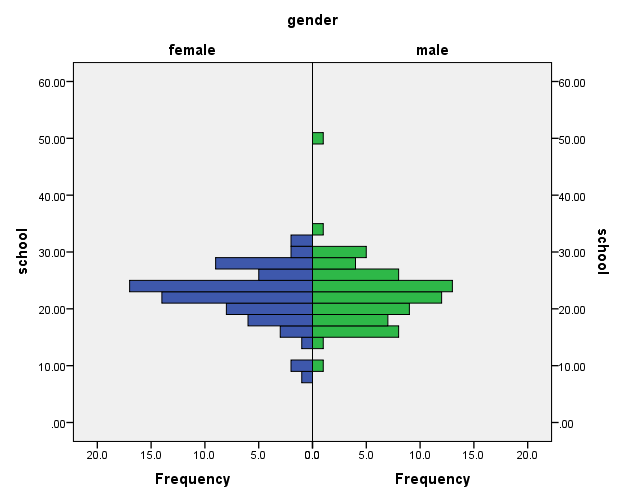
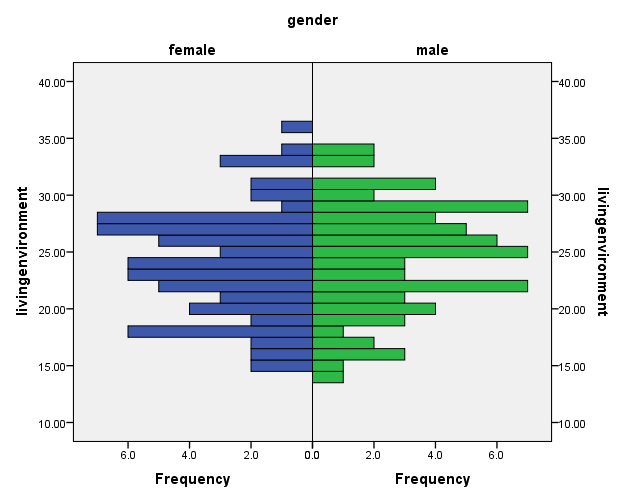
Conclusions
Life satisfaction is the main indicator of psychological and socio-emotional balance for each
individual. Our personality, seen as a social construct, requires a permanent adjustment to social
demands, thus the domains of life satisfaction – family, school, living environment, friends and self –
represent personal and professional constituents of each individualʼs self-regulation. A high level of life
satisfaction requires the development of several abilities, such as self-motivation, involvement, the wish
to succeed or the pursuit of the positive aspects in oneʼs life, in other words the development of positive
thinking. At the same time, students who prove a low level of satisfaction in terms of family experiences
require different methods of intervention compared to those students who show a low level of satisfaction
in terms of school experiences. Therefore, this study proves its usefulness not only through its theoretical
value for further scientific research, as life satisfaction in adolescence and early adulthood has not yet
been one of its frequent objectives, but also for those educators who are inquiring how to and where from
to begin their different approach on students.
Students are a particular type of young adults: they are not yet involved in the field of work or
fully responsible for their lives. Nonetheless we can conclude that these young people (responsible for a
part of their life, including academic development for their future active life) show their satisfaction
towards specific activities and areas of interest, which make them happy, enthusiastic and appreciative.
References
- Agyar, E. (2013). Life satisfaction, perceived freedom in leisure and self-esteem: The case of physical
- education and sport students. Procedia - Social and Behavioral Sciences, 93, 2186 – 2193
- Alahdad, R., AlavI, M., Ninggal, T & Mirzaei, F. (2014). Identifying Major Traits of Personality towards Life Satisfaction among Married Students. Procedia - Social and Behavioral Sciences, 114, 394 – 398 Ardahan, F. (2012). Life satisfaction and emotional intelligence of participants/nonparticipants in outdoor sports: Turkey case. Procedia - Social and Behavioral Sciences, 62, 4 – 11 Beutell, N. (2006). Life satisfaction, a Sloan Work and Family Encyclopedia entry. Retrieved from The Sloan Work and Family Research NetworkCivitci, N. & Civitci, A. (2015). Social Comparison Orientation, Hardiness and Life Satisfaction in Undergraduate Students. Procedia - Social and Behavioral Sciences, 205, 516 – 523 Diener, E., Oishi, S. & Lucas, R.E. (2003). Personality, culture, and subjective wellbeing: Emotional and cognitive evaluations of life. Annual Review of Psychology, 54, 403-425Diener, E. (1994). Assessing subjective well-being: Progress and opportunities. Social Indicators Research, 31, 103-159.
- Frisch, M. (2006). Quality of life therapy. New Jersey: John Wiley & Sons, Inc. Hoboken Hong, S. M., & Giannakopoulos, E. (1994). The relationship of satisfaction with life to personality characteristics. Journal of Psychology Interdisciplinary & Applied, 128(5), 547-558 Huebner, E. S. (2001). Manual for the Multidimensional Students’ Life Satisfaction Scale. Retrieved from: http://www.psych.sc.edu/faculty/Scott_Huebner Lewinsohn, P. M., Redner, E., & Seeley, J. R. (1991). The relationship between life satisfaction and psychosocial variables: New perspectives. Pergamon., 93-212 Mohammadi, A. (2011). Survey the Effects of Life Skills Training on Tabriz High School Student’s Satisfaction of Life.Procedia - Social and Behavioral Sciences, 30, 1843 – 1845 Ozgur, G.,Babacan Gumus,A. & Durdu,B. (2010). Life Satisfaction of University Students Living at Home or in the Dormitory. Journal of Psychiatric Nurses, 1(1):25-32.
- Pavot, W. & Diener, E. (1993). Review of the Satisfaction With Life Scale. Psychological Assessment, 5, 164-172.
- Pânișoară, G., Sălăvăstru, D., Mitrofan, L. (2016). Copilăria și adolescența. Provocări actuale în psihologia educației și dezvoltării. Iași: Polirom Roberts, B. W., Kuncel, N. R., Shiner, R., Caspi, A., & Goldberg, L. R. (2007). The power of personality: The comparative validity of personality traits, socioeconomic status, and cognitive ability for predicting important life outcomes. Perspectives on Psychological Science, 2(4), 313-345.
- Sahin, S. (2008). Burnout and Life Satisfaction Level of Physical Education Teacher , Mersin University, Institute of Healthy Sciences, Master Thesis
- W.E., V., R., Scherpenzeel, A.C., Bunting B. (1996). A comparative study of satisfaction with life in
- Europe. The study of life satisfaction, 11-48.
- Topaloglu, A. O. (2015). The Relationship between University Students’ Self Perception, Life
- Satisfaction and Various Variables. Procedia - Social and Behavioral Sciences, 205, 349 – 355
Copyright information

This work is licensed under a Creative Commons Attribution-NonCommercial-NoDerivatives 4.0 International License.
About this article
Publication Date
25 May 2017
Article Doi
eBook ISBN
978-1-80296-022-8
Publisher
Future Academy
Volume
23
Print ISBN (optional)
-
Edition Number
1st Edition
Pages
1-2032
Subjects
Educational strategies, educational policy, organization of education, management of education, teacher, teacher training
Cite this article as:
Sandu, M. C., Chirca, R., & Pânișoară, G. (2017). Identifying Life Satisfaction Among The Students From The University Of Bucharest. In E. Soare, & C. Langa (Eds.), Education Facing Contemporary World Issues, vol 23. European Proceedings of Social and Behavioural Sciences (pp. 1240-1247). Future Academy. https://doi.org/10.15405/epsbs.2017.05.02.152

